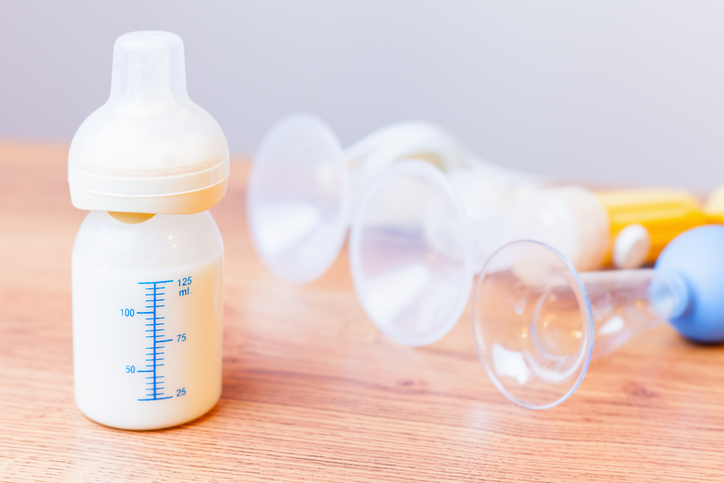How do I know if my baby is getting enough breast milk?
Midwife, Bel Moore, sheds light on breast milk, and how to make sure your baby is getting enough.
‘Perceived insufficient milk supply is one of the most common reasons women (an estimated 35 per cent of them) stop breastfeeding and switch to formula or begin mix feeding.
Even if supply is genuinely low, it is usually a temporary situation that can be improved with appropriate education and support.
A quick lesson in milk production…
1. Colostrum
Starts being produced from about 16-22 weeks gestation, high levels of progesterone keeps the volume of colostrum down.
Once the placenta is delivered, progesterone levels drop, leaving high level of prolactin that “brings in the milk” about 50-73 hours post birth. This stage occurs whether or not a mum is breastfeeding as it is a hormonally driven action.
2. Establishing lactation
Milk production is controlled at the breast by milk removal.
Milk removal is driven by the baby’s appetite or a pumping routine. Basically the more milk removed, the more milk will be made (supply and demand).
When the nerves in the nipple are stimulated (by touch, sucking or a pump), oxytocin is released and causes the breast to “let down” (push the milk out the ducts). Milk volume is usually greater in the morning and decreases in the evening, but the fat content is also usually higher as the day progresses.
Storage capacity of breasts varies widely between mums and is not determined by breast size. Mums with smaller capacity may have to feed more.
Busting low breast milk supply myths

Please note the following DO NOT necessarily indicate a low milk supply:
1. Baby feeds often
Babies’ naturally feed 8-12 times in 24 hours. Their stomachs are small (a newborn’s is as big as a marble!) and breast milk is easily digested. Frequent feeding is needed for a good supply.
2. Breasts feel soft or don’t leak anymore
Your breasts adjust to your baby’s needs in the first 3-12 weeks (usually around 6) and therefore you may not feel ‘full’, hard or leak after this period.
3. Baby starts to feed more frequently
This can happen during ‘growth spurts’ or in the evenings when there is less milk available (the dreaded witching hours!). Frequent feeding will help increase and maintain milk supply.
4. Baby only feeds for a short time
Babies become more efficient in feeding over time and can empty a breast in 5- 10 minutes.
5. Baby won’t sleep through the night
Sleep is a developmental milestone, they will reach it when they are ready. Waking at night is protective of SIDS. Over night feeds are important to milk production, as this is when prolactin (milk making hormone) is at it’s highest.
6. Can only pump a small amount
Due to the mechanism of pumping being different to a baby suckling, some people aren’t able to pump as much as what a baby would take and therefore it is a poor indication of supply levels.
Reasons why some women do not produce enough breast milk
Some of the reasons why some women are unable to exclusively breast feed their baby include:
- Insufficient glandular tissue
- Medical conditions such as thyroid issues, diabetes and PCOS
- Breast or nipple surgery
- Medications such as hormonal birth control, cold and flu drugs and smoking
- Baby having sucking difficulties/sub optimal latch and draining of the breast (premature, tongue tie, cleft lip/palate)
- Not removing milk from breast e.g. feeding schedule, mix feeding, missing feeds due to dummy use
So… how do you know if baby is having enough?

Signs of a good milk supply include:
- At least 5 very wet disposable nappies (or 6-8 wet cloth nappies) in 24 hours. Urine should be very pale yellow/clear and odourless.
- Depending on age, usually 3 or more soft/runny mustard coloured poos after day 4.
- Baby is alert and reasonably content between feeds (normal for them to have some fussy periods where they feed more frequently).
- Some weight gain and growth in length and head circumference (weighing on same scales and without clothes/nappy is important for accuracy).
To ensure an adequate supply:
- Feed baby on demand (usually 8-12 times a day).
- Avoid use of dummy’s, bottles and formula top ups.
- Empty the breasts as thoroughly as possible at each breastfeeding/pumping session.
- Ensure good latch for efficient nursing.
- Offer both sides if baby wishes.
To increase a low supply:
- Frequently stimulate and empty the breasts (2-3 hourly). Express after feeds/between feeds if necessary.
- Place baby skin to skin to increase the hormones involved in milk production.
- Ensure good attachment at breast.
- Reduce/ stop top ups of formula and dummy use.
- Take care of yourself Rest. Sleep, Relax. And drink to thirst (extra water does not increase supply).
- Seek advice and support from a lactation consultant, maternal and child health nurse, midwife or any breastfeeding support websites or Facebook groups in your area.
- Medicine prescribed to increase supply by a doctor should be last resort due to side effects and should only be considered after consulting with a lactation consultant.
So there you have it. Some information to help you understand and determine if your baby is getting enough breast milk.
If you do have any concerns, it’s always best to speak with your location nurse and or healthcare provider.’
Bel Moore is a Midwife, Registered Nurse, Nurse Immuniser, Babywearing Consultant and is currently completing a Post Graduate Certificate in Child and Family Health at the University of Technology Sydney. She is passionate about antenatal education, breastfeeding support and keeping fit. Bel is a solo mummy to a beautiful two year old, Oliver.




